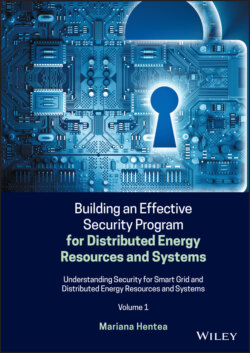Читать книгу Building an Effective Security Program for Distributed Energy Resources and Systems - Mariana Hentea - Страница 44
1.6 Integrated Systems in a Smart Grid
ОглавлениеOT represents a broad category of applications that utilities use for operations that include safe and reliable generation and delivery of energy. OT includes power equipment (e.g. operating gear, oil circuit breakers, solid‐state relays, and many devices in between) and control room applications such as SCADA systems that monitor the network, reaching out to devices as complex as substation gateways or to devices as simple as sensors. OT is often applied within a mission critical framework.
If OT is more focused in operations, IT systems are just the opposite. IT systems allow machines to exchange information directly with humans, usually within a second or longer. Examples include improved enterprise resource planning (ERP), geographic information systems (GIS), and customer relationship management (CRM) systems, along with office‐based productivity tools and mobile computing devices, which have now permeated the utility workplace. Until recently, the growth in IT stood independent of the hidden OT equipment, serving and protecting the grid. The interconnection of a wide array of traditional and emerging utility business and operation information systems such as EMS, DMS, SCADA, market management system (MMS), AMI, Customer Information System (CIS), and outage management system (OMS) allows the utilities, customers, and other service providers not only to monitor energy usage and grid status with higher precision and accuracy but also to analyze and activate distributed energy resources and storage options and construct pricing responses to appropriately reorient consumption patterns to balance available power generation capacity and demand continuously – all in real time. These activities require secure automated information exchange, analysis, and intelligent decision making distributed throughout the grid.
Therefore, the picture is starting to change. The Smart Grid is transforming utility operations and pushing IT across its traditional boundary into OT so rapidly that is blurring the distinction between the two categories (see Figure 1.21). The dynamics of IT and OT integration and how utilities can leverage this convergence for smarter, more cost‐effective, and more reliable operation are discussed in [Meyers 2013].
Figure 1.21 OT and IT integration. ERP, Enterprise Resources Planning; EAM, Enterprise Asset Management; GIS, Geographic Information Systems; CRM, Customer Relationship Management; CIS, Customer Information Systems; OMS, Outage Management System; DMS, Distribution Management Systems; DG, Distributed Generation; DER, Distributed Energy Resource; HAN, Home Area Network; AMI, Advanced Metering Infrastructure; DSCADA, Distribution Supervisory Control And Data Acquisition (DSCADA)
Smart meters and home area network technologies are also helping to blur the lines between the energy supply and energy distribution domains. For example, the OMS at many sites has migrated away from the enterprise and toward the operation domain.
